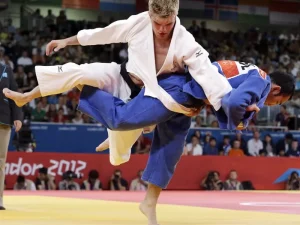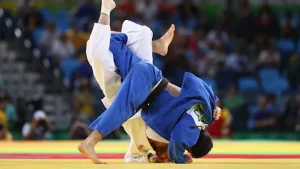Judo is a situational, complex coordination, acyclic, speed-power type of martial arts, the essence of which is reduced to a duel between two judoka athletes, each of whom strives to win with the help of standing wrestling techniques (throws) or lying wrestling techniques (pain techniques, suffocating captures , maintenance) in strict accordance with the Competition Rules.

Judo fights take place on a special carpet called tatami, which consists of a set of individual mats measuring 1m x 1m x 4cm or 2m x 1m x 4cm, made of polymer materials. Tatami consists of two zones of different colors. In the center of the tatami there is a square with minimum dimensions of 8m x 8m and maximum dimensions of 10m x 10m, which is called the working area and consists of mats of the same color. The outer part of the tatami, called the safety zone, consists of mats of a different color and has a perimeter of 3 m. In the central part of the working area, at a distance of 4 m from each other, white and blue stripes with a width of about 10 cm and a length of about 50 cm are applied to the mat, which serves to mark the places of the participants before the start of the match and after it ends. Any match begins and ends with both judokas bowing to each other.
According to their nature, judo competitions are divided into individual and team competitions. In individual competitions, only personal results and places are determined, in team competitions, teams meet each other and the results of these meetings determine the places of teams.
Depending on the elimination system, the competitions are held in the Olympic system with consolation matches for the semi-finalists, or in the Olympic system without consolation matches, or in the round-robin system, or in the mixed system.
Judo competitions are held in certain age groups:
- Younger age – boys and girls up to 12 years old.
- The average age is boys and girls up to 14 years old.
- Cadets – boys and girls up to 18 years old.
- Junior boys and girls – up to 21 years old.
- Youth – up to 23 years old.
- Men and women.
- Veterans – after 30 years.
Contestants are divided into weight categories. For boys and girls, there are 9-10 weight categories depending on age, for juniors up to 21 years old – 8 weight categories, for young people up to 23 years old, as well as for men and women – 7 weight categories. In addition, for men and for women, competitions can be held in the absolute category, where the weight of the participants is not taken into account.
The duration of the match is determined by the age group of the participants:
- Younger age – 2 minutes.
- The average age is 3 minutes.
- Cadets, juniors, adults – 4 minutes.
- Veterans under 60 years old – 3 minutes, over 60 years old – 2 minutes.
A judoka’s suit is called a judoga and consists of three parts: a jacket, pants and a belt, the color of which determines the level of technical training of a judoka. The judoga must be blue for the participant called first, and white for the second participant. Judoga is made of cotton or similar material. For female athletes, a white t-shirt should be a mandatory part of the costume. A judoka’s suit must meet certain requirements. The jacket should be long enough to cover the hips and reach the hands, which are lowered along the body. The jacket should be wide enough to fit from left to right by no less than 20 cm at the level of the lower part of the chest. The sleeves of the jacket should be at most up to the wrist and at least up to a point 5 cm above the wrist. Along the entire length of the sleeve, there should be a space of 10-15 cm between the sleeve and the jacket.

Pants should be long enough to cover the legs at most up to the ankle joint or at least up to a point 5 cm above it. There should be a space of 10-15 cm along the entire length of the leg between the leg and the pants. A belt with a width of 4-5 cm should be wrapped twice over the jacket and tied at waist level with a flat knot. The length of the belt should be such that the ends remain 20-30 cm long. If the costume of the participant does not meet the requirements of the Rules, the judge in control or the arbitrator may require the participant to change the costume.
The match is refereed by a team of judges, which includes an arbitrator and two side judges. The referee is usually located within the working zone, manages the match and expresses his attitude to the actions of the athletes, as well as the joint decision of the team of judges with special gestures and signals. Side judges are located in opposite corners outside the working area. Each side judge must express his opinion, if it differs from the referee’s decision, when announcing technical actions or penalties by means of appropriate official gestures.
The match always starts in a standing position on the command of the referee “HAJIME”. If it is necessary to stop the match, the referee announces the command “MATE”. After the signal for the end of the match, the referee gives the command “SORO-MADE”.
In the event that the evaluations of the judokas after the match are the same or there are no evaluations, an additional “GOLDEN SCORE” match is assigned, which lasts until
